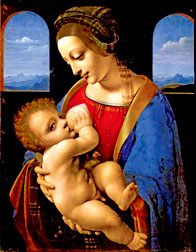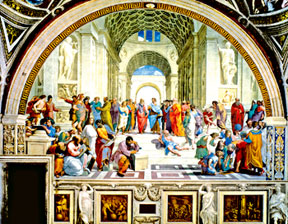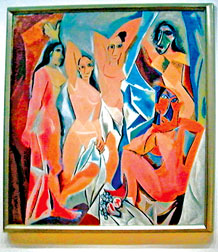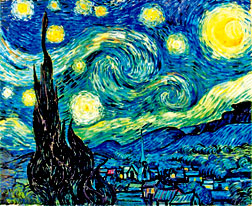|
Weekend
The immortal painters
Lionel WIJESIRI

Madonna Litta by Leonardo da Vinci |
IF SOMEONE asks me who I you think were the 10 greatest painters of
all time, few names will crop up into my mind immediately: Michelangelo,
Velazquez, Rembrandt, Picasso, da Vinci, Pollack, Van Gogh, Raphael,
Monet and Warhol. But not necessarily in that order! To me there is no
“one” best painter. I think many of the above gained experience from
some of the others.
I believe a great painter is someone who is a master of the medium
and whose works cannot be seen to the eye yet understood by the mind.
Take for example, Michelangelo and Picasso. Both had profound
understanding of their medium.
The brushworks of both were quite exquisite. Their
compositional/design senses were out of the world. Both were great
painters. But the basic theme of Michelangelo was humanism while Picasso
relished on modernism and subjectivism.
It would be difficult and not ethical to ‘compare’ Michelangelo to
Picasso (apples and oranges maybe). Studying the work of the old masters
is inspiring.
There’s a lot we can learn by studying their methods, palettes, and
techniques. It’ll inspire us and help us to expand our knowledge of
their painting methods and approaches. Today let us take a look at four
well-known masterpieces and review some revealing observations made by
the leading specialists about these works.
Les Demoiselles d’Avignon

The School of Athens by Raphael Sanzio |
Les Demoiselles d’Avignon (The Young Ladies of Avignon) is a
celebrated painting by Pablo Picasso that depicts five prostitutes in a
brothel. Picasso painted it in the summer of 1907.
This painting is regarded as one of the most important in the early
development of Cubism. (Incidentally, cubism is a painting style that
developed in the early 20th century emphasising the representation of
natural forms as geometric shapes seen from several angles).
At the time of its first exhibition in 1916, the painting was deemed
immoral. Picasso drew each of the figures differently. The woman pulling
the curtain on the far right has heavy paint application throughout. Her
head is the most cubist of all five, featuring sharp geometric shapes.
It is said that the cubist head of the crouching figure underwent at
least two revisions from an Iberian figure to its current state.
The masked figure was derived from African tribal masks with green
stripes and sharp edges. The two Iberian figures in the centre were
influenced by Iberian sculptures, and are characterised as such because
of their prominent ears and wide eyes.

Les Demoiselles d’Avignon by Picasso |
Leo Steinberg in his landmark essay “The Philosophical Brothel”
argues that the viewer is forced to confront the gaze of prostitutes
head on, invoking readings far more complex than a simple allegory that
attempts to understand the work.
He suggests the work as a meditation on the danger of sex, the
“trauma of the gaze”, and the threat of violence inherent in the scene
and sexual relations at large. In July 2007, Newsweek published a
two-page article about Les Demoiselles d’Avignon describing it as the
“most influential work of art of the last 100 years”.
Madonna Litta
Madonna Litta (by Leonardo da Vinci) is unquestionably one of the
loveliest paintings the world has preserved. The finer aspects of
smoothness of the figures, colouring of the dress against the serene
atmosphere of the landscape and facial expression of child Christ reveal
subtle finesse.
This work was done sometime in the 1480s for the Visconti rulers of
Milan and soon passed to the Litta family, in whose possession it
remained for centuries. The painting was briefly featured in the 2006
film The Da Vinci Code.
The Madonna’s sublime, tender gaze as she looks at her son, and the
tranquillity of the distant mountainous landscape, reflect humanist
dreams of ideal man and a harmonious life. The painting reveals great
harmony in its colouring and composition.

The Starry Night by Vincent van Gogh |
This painting was completed at a time when Leonardo was experimenting
with different mediums. The style displays the Lombard influence under
which Leonardo worked during his first sojourn in Milan; this style is
characterised by a very stark modelling of the figures, quite different
from the Sfumato of his later works. (Sfumato is the painting technique
which overlay translucent layers of colour to create perceptions of
depth, volume and form. In his Mona Lisa, for example, art historians
have argued over whether or not the Mona Lisa is smiling. This debate is
due to the use of Sfumato around her mouth)
The Starry Night
The Starry Night is a painting by Dutch post-impressionist painter
Vincent van Gogh. Widely hailed as his magnum opus, the painting is
regarded as one of his best. The Starry Night was completed near the
mental asylum of Saint-Remy, 13 months before Van Gogh’s death at the
age of 37. One may begin to ask what features within the painting are
responsible for its ever-growing popularity.
Look carefully! There is the night sky filled with swirling clouds,
stars ablaze with their own luminescence, and a bright cresset moon.
This sky keeps the viewer’s eyes moving about the painting, following
the curves and creating a visual dot to dot with the stars. Below the
rolling hills of the horizon lies a small town.
There is a peaceful essence flowing from the structures. To the left
of the painting there is a massive dark structure that develops an even
greater sense of size and isolation. From a mountain to a leafy bush,
the analysis of this formation is wide and full of variety. The painting
is indeed a masterpiece and a work of genius.
The School of Athens
The School of Athens or “Scuola di Atene” is one of the most famous
paintings by the Italian Renaissance painter Raphael Sanzio. It was
painted between 1509 and 1510 as a part of Raphael’s commission to
decorate with frescoes the rooms that are now known as the Stanze di
Raffaello, in the Apostolic Palace in the Vatican.
The School of Athens shows the greatest philosophers, scientists and
mathematicians of classical antiquity. Plato and Aristotle are standing
in the centre of the composition at the top of the steps. Their gestures
correspond to their interests in the philosophical field - Plato is
pointing upwards towards Heaven and Aristotle is gesturing towards the
earth.
Diogenes is lying carefree on the steps before them to show his
philosophical attitude. To the left, the man leaning on the block is
Michelangelo. Raphael’s self portrait is at the far lower-right of the
fresco, the young man with brown hair staring straight out at the
audience.
On the left of the painting a girl-like figure, dressed in white, is
also staring out at the audience. Romantic legend has it that the model
was Raphael’s love, Margherita.
All these paintings have certain qualities in common. They have a
wonderful sense of stillness and balance. They are complex paintings
with many layers of meaning. They are about art and fame; the
relationship between a painter and his subject; and between a human
being and life. |

